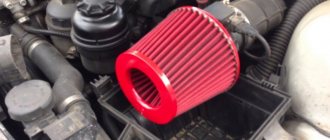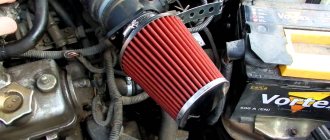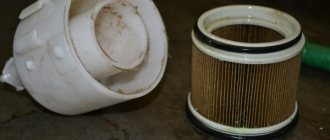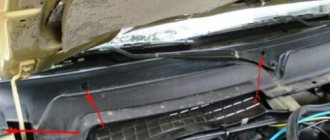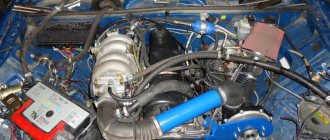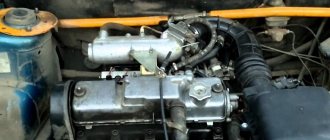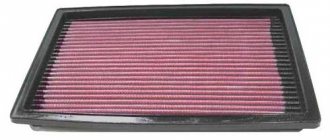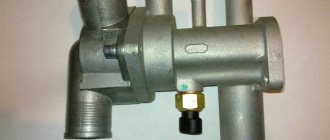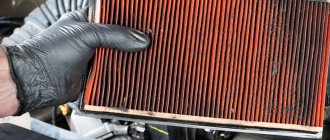Hi all! Next up we have a fairly relevant and interesting topic. After all, we will talk about the zerovik filter. Many people have heard about such an air filter, but not everyone knows exactly what it is, what it is needed for and what use it is.
The nulevik is installed instead of the air filter in its normal place. And here it is important to understand what such a device provides. I’ll say right away that there are pros and cons to it. But for the sake of objectivity, I will first try to tell you in detail about the device, and then sum up whether there is any benefit in this purchase, whether it is worth installing a nulevik on a car, on a moped, on some VAZ or on a carburetor, for example. After all, there are very often craftsmen on the Internet who install a device for Pidburg on Alpha, that is, on a scooter.
Don't forget to share your opinion. Especially if you have personal experience in using zero resistance filters. This is exactly what it is correct to call zeros.
Why is this necessary?
First, let's figure out what it is and what it is eaten with. A standard or regular air filter is designed to clean the air entering the engine from all kinds of contaminants. It is due to air filtration that power loss occurs.
This is due to the fact that the cleaning elements in the filter design (usually special paper) create resistance to air flow. This is not surprising since the filtration material is very dense. And the higher the resistance, the more the final power is lost. As you know, increasing power is achieved by increasing the amount of incoming air. This is where the zero impedance filter comes into play.
Nulevik is an alternative to the standard cleaner. Its design is such that the device reduces intake resistance without sacrificing air purification itself. This results in an increase in power.
And here a logical question arises: is your Priora, VAZ 2112 or VAZ 2114 worthy of such an element? Is it even worth buying a zero car if you want to slightly increase engine power?
Practice and research show that such a small tuning as installing a zero level allows you to get an increase of 3-5% in power. If this is a low-power car, then you definitely won’t feel an increase of several horsepower. You also won't see any difference in dynamics. But the numbers will be higher than you can comfort yourself a little.
Key Benefits
Reading reviews about nuleviks, I came across many conflicting opinions. One installed such a filter on his injector and was very pleased. Another spent a lot of money on a K&N zero and its installation, wanted changes, but in the end all he got was wasted time. And there are many such examples.
I’ll say right away that ordering zero-resistance filters from auto stores is not a problem at all. The price for some models is quite reasonable, so it is not difficult to buy and is relatively inexpensive. But whether such an element needs to be installed on a VAZ with your own hands is an extremely interesting question.
Let's start with the good. Like any device, the Nulevik has its pros and cons. The disadvantages include the cost compared to a conventional air filter and the need for constant cleaning.
As for the advantages, there are several of them.
- Power increases. The nulevik has a complex design that allows it to reduce resistance. This gives an increase in horsepower;
- Simultaneous cleaning efficiency. Although the resistance drops, this does not affect the quality of air purification;
- Replacement frequency. There is no need to change the nulevik as often as a regular filter. They are washable. This allows you to return full performance characteristics;
- Increase in characteristics. Albeit a little, but the zero gear adds power and increases torque;
- Sound. For many, it is not the power that is important, but the sound characteristic of powerful engines. Nulevik creates such an effect, and as a result the car sounds very interesting.
To achieve what you want, you will have to remove the standard filter and install a zero-resistance device in its place. Decide for yourself which is better, buy and install it yourself, or give the car to the experts. In the second case, there will be a guarantee of quality and a well-chosen filter. The main thing is that the specialists themselves are qualified and reliable.
Advantages
The three percent of power that the installation of a zero filter gives is not determined by every stand, let alone a person while driving in normal conditions around the city. Therefore, the advantages of the nullik include:
- Increase engine power by 3-5%.
- Spectacular appearance during inspection and oil changes.
- Unconditional advancement in the ranking of the fastest cars in the neighborhood.
But this barrel of honey will also have to add a small fly in the ointment. The fact is that a cheap filter practically does not clean the air, but it creates resistance and also gets clogged. Therefore, it also needs to be changed, and much more often than a regular, standard filter. A good zero filter is enough for 3000 km at most, but no one measures the resources of bad handicraft filters. A good zero filter will only reach its service life if it is constantly treated with a special aerosol.
But there is a point
There is a common misconception that by removing the filter and housing you can significantly increase engine power. This is completely untrue.
It is important to take into account that when developing an engine, a careful calculation of the valve timing is made, which takes into account errors and losses on the filter. And if dust starts to enter the engine, it will definitely not be able to work for a long time. Here it is necessary to have a fence that will prevent the penetration of contaminants. Resistance can be reduced by widening the passage holes. But then the quality of filtration will decrease.
Before looking for a product code and buying a zero for your motorcycle or car, remember one simple truth. For cars without a powerful sports engine, the cost of purchasing such a filter will be absolutely pointless. You will only waste several thousand rubles. The only thing you will get is a slightly changed engine sound.
Nuleviks are only suitable for sports cars and cars with powerful power plants. The use of such a filter on serial engines is allowed only in cases where a comprehensive modification is carried out. That is, boring is done in the cylinders, an enlarged throttle valve is mounted, sports camshafts are installed, etc. You can also put a zero in the kit with them.
Service issue
If you decide to install a zero filter instead of a standard type air filter, then you will have to take extra care of it. The essence of care is cleaning and periodic impregnation with solutions. Moreover, during care, a certain technology is strictly observed.
If you don’t do this, your car’s fuel consumption will increase significantly, power will drop, and the car will begin to react poorly to increased speed when you press the gas pedal.
- remove the filter;
- clean dirt with a soft brush;
- remove dirt from the seat;
- rinse the filter with water;
- shake several times rather than dry;
- apply cleaning agent on both sides;
- install in place.
If the car is operated in fairly harsh conditions, then such preventive maintenance is carried out at least every 8 thousand kilometers. For normal conditions, 10-12 thousand km is enough. One zero can be washed up to 20 times. Then a mandatory replacement.
What can be said about such zero-resistance filters? They look impressive in the photo, are expensive and, in theory, have important advantages over standard filters. But when applied to production cars they are useless. It is a fact.
It is important to install nuleviks on powerful sports engines and engines that are subject to serious technical tuning. The filter itself will not improve the weather on engines whose power does not exceed 120-150 horsepower.
What do you think about this? Is there any sense in nuleviks, or is it a useless waste of money? Write your opinion in the comments.
That's all I have. Thanks to everyone who is with us! Subscribe, ask questions and invite your friends to join us!
(No ratings yet)
Did you like the article?
Subscribe to updates and receive articles by email!
We guarantee: no spam, only new articles once a week!
- Do-it-yourself zero-resistance filter: helping the engine breathe easier
- What is a zero resistance filter?
- Pros and cons of a zero resistance filter
- The difference between a conventional air filter and a zero-resistance filter
- Zero resistance filter care
- Stages of creating a zero-resistance filter with your own hands
- Tools and Items to Create a Zero Resistance Filter
- Installing a zero resistance filter
Many car owners, wanting to improve the power and dynamic characteristics of the car with their own hands, decide to install a zero resistance filter . It is difficult for an uninitiated person to judge how justified such a step is. Among motorists, there are directly opposite opinions regarding such a car modernization. Some are confident that installing a “nulevik” can significantly increase the power of an engine “strangled” by a standard air filter, and therefore, it is not only necessary, but vital.
Others argue that one zero-resistance filter is not enough to boost the power unit, therefore there is no point in it, and besides, there is a prejudice that such a device copes much worse with its main task - cleaning the air entering the engine. As usual, the truth lies somewhere in the middle, but first things first.
What is a zero resistance filter?
Atmospheric air contains many mechanical impurities, primarily dust, which, once inside the engine, can sooner or later damage it. To prevent a premature end, this air must be purified. To do this, you need an air filter, which carries out mechanical cleaning.
Its filter element consists of several layers of cotton fabric, impregnated with a special agent and placed between an aluminum screen. It allows air flow to pass almost unhindered into the engine. Dirt particles from the passing air flow adhere to the fibers, practically without reducing the filter capacity.
Pros and cons of a zero resistance filter
The advantages of a zero resistance filter are:
— a small increase in power, especially if the filter is installed in conjunction with some other modifications to the engine or exhaust;
— a change in the sound of the engine, or rather, a different sound appears precisely from the zero-resistance filter, so it would be more accurate to say a change in the sound coming from under the hood;
— the appearance of the engine compartment becomes more sporty, some people install a zero gear just for this reason.
The disadvantages of a zero resistance filter are:
— constant filter maintenance;
- cheap filters of zero resistance can very poorly clean the air passing through them, because of this the engine oil will become contaminated faster, and the engine itself can quickly fail.
The difference between a conventional air filter and a zero-resistance filter
A standard air filter has a different structure compared to a zero-resistance filter. A conventional air filter is made of a fairly dense material; it cleans the intake air well, but also provides serious resistance to the air flow passing through it. The zero-resistance filter consists of layers of cotton fabric, plus it is completely impregnated with a special composition, due to which dust sticks to the outer part of the filter and does not get into the inside of the motor. That is, in a nulevik, air purification, roughly speaking, occurs due to the adhesion of dirt, and the air passes unhindered into the engine. To be honest, this method of air purification does not provide good results; a lot of dust still gets into the engine, and if you don’t clean the zero filter in a timely manner, then the filter will be of no use at all.
Zero resistance filter care
As already mentioned, the zero-resistance filter requires maintenance. The filter needs to be removed and washed; this procedure should be performed approximately once every 5,000 km, and if you drive in a particularly dusty area, then this should be done even more often. So, the procedure for caring for a zero resistance filter:
1. remove the zero from the car and remove all the dust from it with a soft brush;
What is a zero and what is it for?
To put it simply, a zero filter is the same air filter and it is designed to clean the air supplied to the cylinders. However, the resistance that the air encounters during the cleaning process is minimized in this type of filter. If we compare the throughput of a nulevik and a standard paper filter, then it will be higher for a nulevik by about 45%, and that’s because conventional filters are based on very dense material. In this case, the engine power directly depends on the incoming resistance. As a result, zero filters increase engine power by approximately 5%. To make it clearer, our beloved VAZ gets about 5 hp. as a bonus. Of course, no one is saying that an additional 5 horses will greatly change the dynamics or will be felt by the driver at all, however, no one is saying that installing only a zero on the carburetor is considered tuning. The carburetor of the sport version requires additional operations to replace jets and improve the throttle valve; even a turbo on the carburetor is installed by individual craftsmen. The design of the zero-resistance filter consists of a frame made of wire, in which there is a filter element made of foam rubber or cotton fabric in several layers. I impregnate the filter element with a special composition for better cleaning and further reduction of resistance.
Cold intake/inlet pipes (9)
The purpose of the standard intake filter of a VAZ car and other cars is to supply atmospheric air purified from impurities and mechanical particles into the engine combustion chamber.
But despite the fact that the standard filter performs its task well, due to its dense structure it makes it difficult for a certain amount of air to enter the combustion chamber, which in turn does not allow increasing the amount of the fuel-air mixture and thereby increasing the pressure on the piston (which We ultimately achieve an increase in power). To reduce these losses, a so-called zero-resistance filter (ZRF) was created.
This section presents low (zero) resistance filters, which are designed to increase the throughput of the entire vehicle intake.
An increase in throughput leads to an increase in the amount of air in the air-fuel mixture, and accordingly, with more air, the combustion process is more efficient, which increases engine power.
In our online store Stingershop you can buy zeros for both carburetor and injection cars.
Carburetor filters differ in that their mounting points are designed to be installed on top of the carburetor, while injection filters have an inlet for docking with the inlet pipe.
Installing a zero resistance filter
Tuning a carburetor with the installation of a zero filter always begins with the question of the correct location of the filter itself. If carburetor tuning is limited only to installing one filter, then it is not difficult to do it yourself and the issue of finding a location is not particularly upsetting, because in principle there is enough space. However, additional tuning elements, such as an installed turbine on a carburetor or compressor, in most cases still forces you to remove the filter from the engine compartment, since there is simply not enough space for it. In addition, there is another positive aspect of bringing the filter outside: there are large flows of air with dust in the engine compartment, and this leads to more frequent clogging of the filter. That is, removing the filter from the engine compartment reduces the frequency of filter washings, and therefore saves money.
In addition to the pros, there are also cons.
- The cost of a zero filter from a well-known brand can reach up to 10,000 rubles, when the original standard filter costs only about 1,500 rubles.
- If you install it separately, without any other modifications, then you not only may not feel the increase in power, but you may also lose it due to hot air being sucked in from the engine compartment.
- If you take the impregnated option, then you need to constantly monitor it. Every 2000 - 3000 kilometers it is necessary to wash, clean and impregnate again. Otherwise, you will not get the necessary increase in power, but on the contrary, it will drop.
There is still debate about the effectiveness of zero-resistance filters. Some argue that they are absolutely useless, others on the contrary. However, world-famous tuning studios always use zeros in their tuning programs.
Nulevik maintenance process
To service the zero-resistance filter, there is a special liquid, the treatment of which must also be carried out strictly according to the instructions. That is, a standard type of removal and installation scheme is not provided here. Periodic maintenance is so important that even a slight delay in this matter can make a big difference at the most inopportune moment. This will immediately become noticeable due to a certain engine sluggishness and significant consumption.
So, the cleaning process looks like this:
- The filter is removed;
- Using a soft bristle brush (this is important), carefully clean the entire filter surface, removing all large particles and dirt;
- A special cleaning liquid is applied to the filter and waited for about 10 minutes until it is completely saturated;
- The filter is washed in a container with plain water, and then under a weak stream of running water;
- There is no need to resort to drying the filter; just shake it several times to remove excess water. And even more so, you can’t dry it with heat, so as not to damage it;
- The filter is installed in place.
Zero resistance filter
For normal vehicle operating conditions, filter maintenance is regulated every 10 thousand kilometers. Harsh conditions force us to double the service frequency, that is, every 5 thousand kilometers. Harsh conditions include frequent trips on dusty roads, regular use of sporty driving at high speeds, as well as the presence of additional tuning elements, for example, a supercharger or turbine installed on the carburetor. In the last two cases, the speed of air intake through the filter is so high that faster contamination of the filter element is possible.
Types of filters.
Manufacturers of zero-resistance filters offer only two options:
- With impregnation. The most popular and effective option. Increases engine power by up to 7% and perfectly cleans the air flow. Among the disadvantages of these filters are the need for frequent maintenance and replacement of special oil impregnation. Due to such impregnation, the filter material becomes sticky, dust and various particles get stuck between the fibers without getting inside.
- Dry. Outwardly, it is similar to a standard factory filter, but gives an increase in power of up to 5% thanks to the cotton filling. One of its advantages is the lack of constant maintenance and replacement of oil impregnation. But it is less effective.
Each manufacturer has its own developments in the field of cleaning elements. Choosing a Nulevik filter for your engine should be based on the needs and capabilities of the car, based on consumer reviews.
Is it worth installing a zero valve on a carburetor?
Of course, if you are tuning a carburetor, then installing a zero leveler is simply mandatory, because the advantages of using it are obvious:
- Power increases, while the quality of air purification does not deteriorate, which means the engine life ultimately increases;
- The question of regularly replacing the filter with a new one goes away, since the zero filter is simply washed;
- Increases torque at low and medium speeds.
However, the increase in power occurs in the range from 6 to 8%, which is not particularly noticeable on driving dynamics, and shelling out a considerable amount of money at once without resorting to other types of tuning is simply not advisable. Therefore, before you set a zero, think: do you need it?
Problems in the operation of the VAZ 2109 (carburetor) related to filters
It happens that the car starts to move jerkily. When checking the engine, nothing is found, but the malfunction is obvious. In such cases, you need to check the fuel filter.
It must be removed (do not lose the special O-ring). After which, the filter is washed with gasoline and purged under pressure.
If no problems are found, also check the additional filter. If it is faulty, it is better to simply replace it.
The Nine fuel filter can cause a lot of trouble for drivers
One more thing - check the oil in the air filter on the VAZ 2109 (carburetor). If oil was found in the air filter, you need to look at the condition of the oil scraper rings on your car. Measure the compression. This is usually the best way to determine the cause of trouble.
